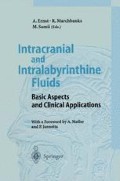Abstract
Displacement of the tympanic membrane causing increased middle ear (ME) impedance is usually followed by deterioration of air conduction (AC) threshold. In normal hearing subjects with mobile ossicles low-frequency bone-conduction (BC) threshold also deteriorates (positive Gelle’s test). This is usually interpreted by influence of middle ear factors: Both the elevation of the resonance frequency of the ossicular chain and reduction of the ostio-tympanic component of BC resulting from increased stiffness1. In contrast, Gelle’s test is negative in patients with a fixed stapes2.
Access this chapter
Tax calculation will be finalised at checkout
Purchases are for personal use only
Preview
Unable to display preview. Download preview PDF.
References
Gelle M. Valeur de l’epreuve des pressions centripetes. Ann Maladies Oreille Larynx 1885; 11: 63
Lehnhardt E. Physiologie der Schalleitung einschließlich Ohrtrompete. In: Berendes J, Zöllner F (Eds.): Hals-Nasen-Ohrenheilkunde in Klinik und Praxis. Vol. 5, 2nd ed. Stuttgart 1979.
Kitahara M, Kodama A, Ozawa H, Izukura H. Mechanism of hearing disturbance due to alteration in atmospheric pressure. Acta Otolaryngol 1994; Suppl 510: 92–95
Allen GW. Clinical implications of experiments on alterations of the labyrinthine fluid pressures. Otolaryngol Clin North Am 1983; 16: 3–19
Suzuki T, Nakashima T, Yanagita N. Effects of increased cerebrospinal fluid pressure on cochlear and cerebral blood flow. Eur Arch Otorhinolaryngol 1993; 250: 332–336
Suzuki T, Kitahara M, Kitano M. The influence of vestibular and cochlear aquaeducts on vestibular response to middle ear pressure changes in guinea pigs. Acta Otolaryngol 1994; Suppl 510: 16–19
Panning B, Mehler D, Lehnhardt E. Transient low-frequency hypocousia after spinal anaesthesia. Lancet 1983; II: 582
Rask-Andersen H, Stahle J, Wilbrand H. Human cochlear aquaeduct and its accessory canals. Ann Otol Rhinol Laryngol 1977; Suppl 42: 1–16
Author information
Authors and Affiliations
Editor information
Editors and Affiliations
Rights and permissions
Copyright information
© 1996 Springer-Verlag Berlin Heidelberg
About this paper
Cite this paper
Maier, W., Ross, U.H. (1996). Round Window Displacement caused by altered middle ear pressure inducing impairment of bone-conduction threshold?. In: Ernst, A., Marchbanks, R., Samii, M. (eds) Intracranial and Intralabyrinthine Fluids. Springer, Berlin, Heidelberg. https://doi.org/10.1007/978-3-642-80163-1_33
Download citation
DOI: https://doi.org/10.1007/978-3-642-80163-1_33
Publisher Name: Springer, Berlin, Heidelberg
Print ISBN: 978-3-642-80165-5
Online ISBN: 978-3-642-80163-1
eBook Packages: Springer Book Archive

